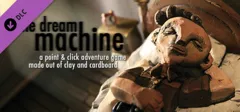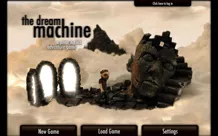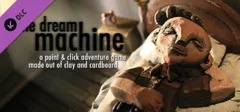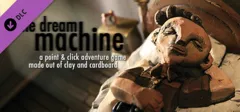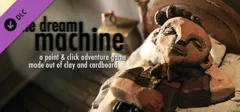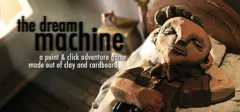The Dream Machine: Full Game
Description
The Dream Machine: Full Game is a compilation of the six episodes of The Dream Machine released between 2010 and 2017.
Groups +
Credits (Windows version)
240 People (209 developers, 31 thanks) · View all
| Designer | |
| Artist | |
| Character Animator | |
| Additional Set Builder | |
| Consulting Producer | |
| Music Composer | |
| Sound Designer | |
| Additional Programmer | |
| Database Programmer | |
| Intern | |
| Quality Assurance | |
| [ full credits ] | |
Reviews
Players
Average score: 4.0 out of 5 (based on 2 ratings)
This isn't a dream, it's a nightmare.
The Good
* The story is wild, weird, and uncomfortably disturbing.
- Tons of variety in themes and settings
The Bad
* Art style is unappealing and grotesque
-
Puzzles in the game's second half are considerably more frustrating and poorly designed
-
Lengthy transitional animations.
-
Weak sound design
-
Technical issues
The Bottom Line
The Dream Machine is a point-and-click game developed in Sweden by two-man indie developer Cockroach, Inc. The game consists of 6 episodes released over an unusually long 6.5 year period.The Dream Machine’s story is intriguingly odd. You play as Victor Neff, a man who is expecting a child with his wife Alicia and has freshly moved in to a new apartment, with unpacking yet to truly begin. After doing some inspection, Victor discovers that him and his wife are being watched through a hidden camera by their landlord, Mr. Morton. It turns out that Morton’s family has been conducting experiments for generations on the apartment’s tenants using the titular device, which allows them to explore and chart the human dreamscape. Unfortunately it has now become sentient, creating soul-sucking roots in the dreams of all of Morton’s subjects, including Morton himself. Victor is then tasked by Morton to destroy the roots of the machine existing in the dreams of the apartment’s tenants.
The game’s plot deals heavily in philosophical, moral, and even religious themes at times. It’s full of references and nods to plenty of past cultural works, yet still comes off as its own unique entity. The game starts out relatively normal before gradually pushing the throttle down towards straight-up weird, with the final two acts forging ahead on all cylinders. While the entire game has a sense of unease and dread, certain parts are going to be highly disturbing and uncomfortable for a lot of players, particularly as the game reaches its final moments. Some people might even be morally offended by a few elements as the game reaches its close. Either way, the game’s story is sure to get at least some sort of reaction out of you.
The most immediate thing about The Dream Machine is how it looks. In the tradition of games such as The Neverhood, The Swapper, and Platypus, the developers have crafted every environment, character, and object out of clay and other found materials. The result is certainly interesting. There’s a ton of variety in the game’s environments, ranging from simple apartments to nightmarishly surreal dreamscapes, all of which are entirely different. Part of the fun is entering people’s dreams and seeing how the dreams reflect that character’s personality and backstory. From cruise ships staffed by clones to Tron-like labyrinths, fairy-tale landscapes and beyond, The Dream Machine will certainly take you, and Victor, to many cool places.
That said, even though it’s hard to outright dismiss the imagination and amount of work which went into creating such a unique look for the game, The Dream Machine can be an incredibly ugly, grotesque-looking game at times. Just about all of the human character designs are downright hideous, and the enivronments are equally gritty and disturbing more than comforting. This ugliness is very much intentional to the themes of the story, but even still there’s an unpleasantness to the way the game goes about conjuring ugliness. I will admit that some of the areas are actually very well done, particularly in the later chapters. Perhaps a better juxtaposition between the ugly and beautiful elements of the game would have helped the art style as a whole, however. There’s a difference between intentional ugliness and accidental ugliness, and I’m not sure the Dream Machine walks that line particularly well. Honestly, I’d argue that all of the games I listed above did this executed this art style in much stronger ways than The Dream Machine.
The technical aspects of the game are even worse. The game was developed using Adobe Flash, which can be surprisingly choppy and resource intensive even on standard laptops. Right-clicking the game window brings up that annoying flash menu. The framerate can be very choppy at times, though a part of me thinks it was done to keep the claymation look of the animation intact. Still, I was surprised at the number of seemingly simple animations which ran very poorly. The game also froze on me a couple of times, and I’ve heard reports of crashes from others I know who have played the game.
Audio-wise, there isn’t much to The Dream Machine beyond simple pointing and clicking sounds. The weird static scream that happens when you enter a dream is unsettling, but much of the game’s audio feels ripped from a custom sound library. There are a few really harsh samples here and there but most everything sticks to Flash game conventions. The music is ominous, atmospheric and unsettling, though it is frequently undercut by the low-quality of Flash’s sound output. Nevertheless, the game does some really neat things with dynamic audio and layering that will send chills down your spine. Some of the diegetic music is really bad, however, a weird mix of jazz and avant-garde rock that feels very out-of-place, and not in a pleasant way. Voice acting is completely absent from the dream machine, and I felt that having some could have done wonders for the story’s emotional impact.
The Dream Machine uses a simple, modern interface much like other recent adventure games. You examine and interact with objects just by clicking on them, while using objects can be done by dragging inventory objects over the environment or onto other objects. Dialogue boxes will also pop up during conversations. The gameplay is all very straightforward, which is great when the story itself is anything but.
Puzzle-wise, The Dream Machine is mostly a pretty solid game. There were a few times which I got stuck, but it was usually because I overlooked a necessary object or an important clue. Many of the puzzles are surprisingly intuitive and fun to solve once you’ve found all of the pieces to put them together, though finding those pieces can be a bit of a chore sometimes, especially when some are too well-hidden. You’ll sometimes need to notice tiny objects that can’t be easily spotted amongst the photographic clutter, though you can highlight interactive objects using the spacebar. The game never really tells you this, so I spent a lot of time during my playthrough stumbling around for minutes at a time until I found the next important item. Some of them make clever use of light physics, including page turning and rummaging around in a box.
I’d say the first four chapters are fairly straightforward in scale and complexity but the last two amp up the difficulty to some pretty insane levels. The later chapters rely heavily on traversing multiple dream worlds and using items from each, which makes for an overwhelming experience as you exhaustively comb a wide area in search of the clues and items you need. The puzzles in the last chapter actually have multiple solutions, but this can leave a lot of red herring items in your inventory as you wonder what they could possibly be used for. Some of the puzzles even rely on a certain level of randomness to activate, which can also be very frustrating. That said, some of these later puzzles are also quite clever and ambitious in their design.
The dream puzzles rely on trippy and whimsical concepts, such as shrinking and moving rooms around in a house. That said, a couple of the puzzles could have used some sort of QOL features to make them quicker and more enjoyable to solve. A key example of this is a puzzle where you must keep clicking an dragging in item onto Victor so he can move between different rooms. It would have been nice for this function to have been a button instead. Some traveling animations also take an unreasonably long time and it would have been nice to have had a skip button for those moments. Little things like that really add up and dent the experience over the course of the game, but the sheer inventiveness of the story and world design are enough to see most persistent gamers through.
The Dream Machine is a game I weirdly liked despite all of the problems it had. It’s a memorably, sometimes unnervingly bizarre journey from start to finish. While the ending may not have been what everyone had hoped for after such a long wait, the journey as a whole is one worth taking provided you’re up for some seriously disturbing and avant-garde content and can overlook the technical and design issues. While I wasn’t personally a huge fan, I’ll concede that its art style is more of a matter of preference than anything else. Much like fellow Swedish indie adventure Fran Bow, The Dream Machine is a wildly unpredictable ride that will grab you until the final credits roll, though it may not leave you feeling quite as satisfied as you’d like.
Macintosh · by krisko6 (814) · 2019
One of the best point and click adventures
The Good
Plot, puzzles, characters and graphic design. Everything is simply amazing. It's a tough experience but it's never unfair.
The Bad
it may be too difficult for inexperienced or not enough patient players.
The Bottom Line
If you love creepy atmospheres with lateral thinking puzzles, an original graphic design all destined to last several hours of your life that's the right game
Windows · by Mark Renton · 2023
Analytics
Upgrade to MobyPro to view research rankings!
Identifiers +
Contribute
Are you familiar with this game? Help document and preserve this entry in video game history! If your contribution is approved, you will earn points and be credited as a contributor.
Contributors to this Entry
Game added by krisko6.
Game added July 19, 2019. Last modified February 22, 2023.

